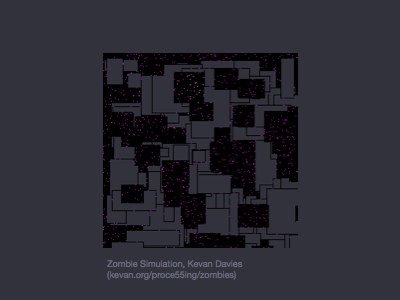Movement
Image source: The presentation itself shows a movie made from a single run of Kevan Davies’ Zombie Simulator.
For some reason, last year I ran into a lot of people who had trained in architecture or urban studies and ended up building for the Web.
I don’t know whether there actually are a disproportionate number of architects working on the Web. Perhaps it was only at the beginning. Do we have any architects here?
(By the way. I have a problem, in presentations, with feeling detached and drifting off the topic. I have a friend who used to be a stand-up comedian and I was asking him for tips on how to get back into the flow when this happens. He said that the reason it happens is because speaking to an audience is a really unnatural situation: normal conversations are two way, but here I’m the only one speaking. So, he said, the way to reattach is to fool yourself into believing you are having a conversation, and one way to do that is to ask a question of the audience. Now I’d always thought that the purpose of me asking you – the audience – a question was to make you feel more engaged. But it turns out it’s not, it’s to make me feel more engaged. So – and I’m just letting you know – when I ask you a question, it’s not really because I care what you think. It’s all about me. Anyway, drifting. Architects.)
I started asking these architects I met why the study of architecture was so appropriate to the Web. I got two complementary answers.
- Architects understand how people move through space, from location to location. You known, people carry mood, associations and objects with them. Their viewpoint varies because people are path dependent. So architects concentrate on paths and relations between spaces, which you can contrast with, say, print designers who have a focus on a single page
- Architects understand that the space shapes behaviour, and that it’s what happens inside the space that matters. This is important for social software: you put objects – page furniture, functionality – in the site not to guide people along a certain path, but to help groups develop richer interactions. And you can guess, but you don’t know, how groups will make that space their own.
So I got these two answers: it’s about how people move through spaces, and about how the form of the positive space shapes what happens in it.
Those are pretty sophisticated ideas, and certainly explains why architects feel so at home on the Web.
By the way, I guess I should explain this image. It’s a run of Kevan Davies’ Zombie Simulator. Zombies chase people around generated courtyards and alleyways which are different every time. The form changes the details of the behaviour, though the zombies win every time. It felt like a good illustration for social software.
